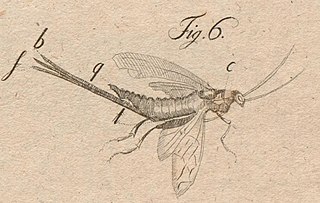Related Research Articles

The Mymaridae, commonly known as fairyflies or fairy wasps, are a family of chalcid wasps found in temperate and tropical regions throughout the world. The family contains around 100 genera with 1400 species.
The Mymarommatidae are a very small family of microscopic hymenopteran insects. Only about half of the known species are living taxa, but they are known from all parts of the world. Undoubtedly, many more await discovery, as they are easily overlooked and difficult to study due to their extremely small size.
The Rotoitidae are a very small family of rare, relictual parasitic wasps in the superfamily Chalcidoidea, known primarily from fossils. Only two extant species are known, each in its own genus, one from New Zealand and one from Chile, and little is known about their biology. Females of the Chilean species, Chiloe micropteron, have their wings reduced to tiny bristles.
Allomymar is a little-known monotypic genus of chalcid wasps belonging to the family Aphelinidae. The only species within the genus is Allomymar taitae and it is possible that Allomymar is synonymous with Encarsia.

Kikiki is a genus of fairyfly wasps containing a single species, Kikiki huna, known from Hawaii, Costa Rica, Nagarcoil and Trinidad. At 0.15 mm (0.0059 in), it is the smallest flying insect known as of 2019. It is a close relative of wasps in the genus Tinkerbella. It was discovered in the Hawaiian Islands by John T. Huber and John W. Beardsley, and published in 2000.

Arescon is a genus of fairyflies. It contains the following species:

Astreptolabis is an extinct genus of earwig in the Dermaptera family Pygidicranidae known from a Cretaceous fossil found in Burma. The genus contains a single described species, Astreptolabis ethirosomatia and is the sole member of the subfamily Astreptolabidinae.

Tytthodiplatys is an extinct genus of earwig in the family Diplatyidae known from a Cretaceous fossil found in Myanmar. The genus contains a single described species, Tytthodiplatys mecynocercus.

Tinkerbella is a genus of fairy wasps, containing the single species Tinkerbella nana from Costa Rica. It is one of the smallest known flying arthropods and belongs to the family Mymaridae. The smallest flying arthropod known was Megaphragma caribea, a trichogrammatid wasp 170 micrometres long, until the discovery of Kikiki, 150 micrometres long.
Ophelimus maskelli is a species of chalcid wasp about 1mm long, known as the eucalyptus gall wasp, found in Australia, New Zealand, Mediterranean Region, and the Middle East. It is considered a plant pest as females lay eggs on immature eucalyptus leaves; the larvae produce galls on the leaves. Heavy infestations induce much galling which causes widespread defoliation and loss of growth. Wasps may emerge in large numbers in the spring, forming clouds which are a nuisance to humans.

Mymarilla wollastoni is a species of fairyflies endemic to the island of Saint Helena in the southern Atlantic. It is the only species classified under the genus Mymarilla. They are characterized by smooth, shiny black bodies and densely hairy (setose) and domed forewings. They bear superficial resemblance to members of the genus Cremnomymar which inhabit similar habitats of remote wind-swept oceanic islands, but they are believed to be most closely related to the genus Stephanodes. They were first described by the English entomologist John Obadiah Westwood in 1879, from specimens collected from low-lying plants in Saint Helena.
Rotoita basalis is a small parasitic wasp in the relictual family Rotoitidae. It is known only from New Zealand, and its closest known living relative is endemic to Chile.
Zigrasolabis is an extinct genus of earwig in the family Labiduridae known from Cretaceous fossils found in Myanmar. The genus contains a single described species, Zigrasolabis speciosa.
Toxolabis is an extinct genus of earwig in the dermapteran family Anisolabididae known from a Cretaceous fossil found in Burma. The genus contains a single described species, Toxolabis zigrasi.
Anaphes nitens is a species of fairyfly, a chalcid wasp in the family Mymaridae. Native to Australia, it is an egg parasitoid of the gum tree snout beetle, a pest of Eucalyptus trees, and has been used in biological pest control of that species.
Anagrus is a genus of fairyflies, in the family Mymaridae, comprising over 80 species, a number of which are employed as biocontrol agents (e.g.,).
Polynema is a genus of fairyflies or fairy wasps, insects in the family Mymaridae.
John Stuart Noyes is a Welsh entomologist.

Xeris is a genus of horntails found in North America and Eurasia. Achille Costa circumscribed the genus in 1894.

Mymar is a genus of fairyflies in the family Mymaridae. There are about 10 described species in Mymar.
References
- ↑ Sankararaman, H.; Manickavasagam, S.; Palanivel, S. (2019). "Description of a new species of Dicopus Enock and first report of Platystethynium glabrum Jin & Li (Hymenoptera: Mymaridae) from India". Oriental Insects: 1–13. doi:10.1080/00305316.2019.1691670.
- ↑ Anwar PT; Zeya SB (2018). "The genus Dicopus Enock (Hymenoptera: Chalcidoidea: Mymaridae)in India with description of two new species". Journal of Asia-Pacific Entomology. 21: 682–687.